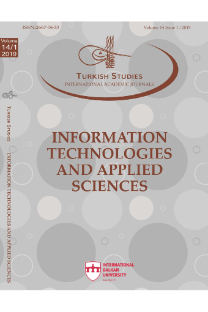DİJİTAL HİKAYE ANLATIMI: İÇERİK ÜRETİCİLERİNİN YOUTUBE VİDEOLARI ÜZERİNDEN BİR ANALİZ
DIGITAL STORYTELLING: AN ANALYSIS OF CONTENT PRODUCERS' ON YOUTUBE VIDEOS
___
- Adaval, R., Isbell, L. M., Wyer, R. S. (2007). “The impact of pictures on narrative‐ and list‐ based impression formation: A process interference model”. Journal of Experimental Social Psychology, 43 (3), 352– 364.
- Altunışık, R., Çoşkun, R., Yıldırım, E. ve Bayraktaroğlu, S. (2010). Sosyal Bilimlerde Araştırma Yöntemleri, 6.Baskı, Sakarya: Sakarya Kitabevi.
- Bennett, L., Segerberg A. (2012). “Digital Media And The Personalization Of Collective Action: Social Technology and Theorganization of Protests Against the Global Economic Crisis,” in Brian Loader and DanMercea (eds.), Social Media and Democracy: Innovations in Participatory Politics. New York: Routledge.
- Bruce D. Weinberg, Ko de Ruyter, Chrysanthos Dellarocas, Michael Buck and Debbie Isobel Keeling(2013). “Destination Social Business: Exploring an Organization's Journey with Social Media, Collaborative Community and Expressive Individuality” Journal of Interactive Marketing, Vol. 27, Issue 4, 299-310.
- Canella, G., (2017), “Social Movement Documentary Practices: Digital Storytelling, Social Media And Organizing,” Digital Creativity, 28:1, 24-37, s25.
- Clark, M. C. & Rossiter, M. (2008). “Narrative learning in adulthood. New Directions for Adult and Continuing Education”, 2008(119), 61–70.
- Couldry, Nick (2008) Digital Storytelling, Media Research andDemocracy: Conceptual Choices and Alternative Futures, Ed. K. Lundby, Digital Storytelling, Mediatized Stories: Selfrepresentations in New Media, New York: P. Lang
- De Certeau, M. J. E. (1984). The Practice Of Everyday Life. Berkeley: University of California Press.
- Escalas, Jennifer E. (2004), “Narrative Processing: Building Consumer Connections to Brands,” Journal of Consumer Psychology, 14, 1, 168–80.
- Frank, A. (2013)The Wounded Story Teller, 2nd edn. Chicago, IL: The University of Chicago Press.
- Gidman, J. (2013). “Listening to stories: Valuing knowledge from patient experience.” Nurse Education in Practice, 13(3), 192–196.
- Gubrium, A. C., Hill, A. L. & Flicker, S. (2014). “A Situated Practice of Ethics For Participatory Visual And Digital Methods in Public Health Research And Practice: A Focus On Digital Storytelling.” American Journal of Public Health, 104(9), 1606–1614.
- Haigh, C., Hardy, P. (2011). “Tell me a story - A Conceptual Exploration of Storytelling in Healthcare Education.” Nurse Education Today, 31(4), 408–411.
- Harper, S. L., Edge, V. L., CunsoloWillox, A. (2012). “Changing Climate, Changing health, Changing stories’ profile: Using an EcoHealth Approach To Explore impacts Of Climate Change On Inuit Health.” EcoHealth, 9(1), 89–101.
- Hendry, P. M., (2007), “The Future of Narrative.” Qualitative Inquiry 13(4): 487–498.
- Jenkins, Henry, (2003), “Transmedia Storytelling.” Technology Review. https://goo.gl/dHfkBD (accessed June 10, 2015).2013 Spreadable Media. New York: NYU Press.
- Jonassen, D. H., Land, S. M. (2000). Preface. In D. H. Jonassen, S. M. Land (Eds.), Theoretical Foundations of Learning Environments (4th ed.). Mahwah, NJ: Lawrence Erlbau.
- Lambert, J. (2006), Dijital Storytelling Cookbook, Dijital Dinner Press.
- Lauren L., I., Markos E., and Milne G., R., (2011), “Online Personal Branding: Processes, Challenges, and Implications,” Journal of Interactive Marketing, 25, 1, 37–50.
- Nordmark, S., Milrad, M. (2012). Mobile Digital Storytelling For Promoting Creative Collaborative Learning Seventhinternational Conference On Wireless, Mobile And Ubiquitous Technology in Education.
- Papacharissi, Z. (2015). Affective Publics. Sentiment, Technology and Politics. Madison, WI: Oxford University Press.
- Pera R., Viglia G., Furlan R. (2016). “Who Am I? How Compelling Self-storytelling Builds Digital Personal Reputation”, R. Pera et al., Journal of Interactive Marketing, 35 , 44-55.
- Prins E., (2017). “Digital Storytelling in Adult Education And Family Literacy: A Case Study From Rural Ireland, Learning”, Media and Technology, 42:3, 308-323.
- Ruyter K., Dellarocas C., Buck M., and Keeling D.I., (2013). “Destination Social Business: Exploring an Organization's Journey with Social Media, Collaborative Community and Expressive Individuality” Journal of Interactive Marketing, 27, 4, 299–310.
- Singh, S., Stephan S. (2012). “Brand Performances in Social Media,” Journal of Interactive Marketing, 26, 4, 189–97.
- Shepherd I. D.H., (2005). “From Cattle and Coke to Charlie: Meeting the Challenge of Self Marketing and Personal Branding” Journal of Marketing Management, 21, 5–6, 589–606.
- Stephen, B., Kozinets R. V., Sherry J. F,. (2003). “Teaching Old Brands New Tricks: Retro Branding and the Revival of Brand Meaning,” Journal of Marketing, 67, 7, 19–33.
- Stolterman, E. (2008). “The Nature of Design Practice And İmplications For İnteraction Design Research”. International Journal of Design, 2(1), 55–65.
- Willox, A.C., Harper S.L., Edge, V.L. (2012). “Storytelling in A Digital Age: Digital Storytelling As An Emerging Narrative Method For Preserving And Promoting İndigenous Oral Wisdom” Qualitative Research 13(2) 127–147.
- Woodside, A. G., Suresh S., and Kenneth E. M. (2008). “When Consumers and Brands Talk: Storytelling Theory and Research,” Psychology & Marketing, 25, 2, 97–145.
- Van Laer, T., De Ruyter, K., Visconti, L. M., & Wetzels, M. (2014). “The Extended Transportation‐ Imagery Model: A Meta‐ Analysis of The Antecedents And Consequences of Consumers' Narrative Transportation”, Journal of Consumer Research, 40, 797– 817.
- ISSN: 2667-5633
- Yayın Aralığı: Yılda 4 Sayı
- Başlangıç: 2006
- Yayıncı: ASOS Eğitim Bilişim Danışmanlık Otomasyon Yayıncılık Reklam Sanayi ve Ticaret LTD ŞTİ
BIG DATA USAGE IN INTERNET ADVERTISING
İbrahim ATEŞ, Esra Ayça GÜZELDERELİ YILMAZ, Aslıhan TÜFEKÇİ
DİJİTAL OYUN BAĞIMLILIĞININ NARSİSİZM KÜLTÜRÜNE ETKİLERİ
TEKNOLOJİK GELİŞMENİN İSTİHDAM ÜZERİNDEKİ ETKİLERİ: TÜRKİYE ÖRNEĞİ
USER DATA IN ADAPTIVE LEARNING SYSTEMS
Neslihan ADEMİ, Suzana LOSHKOVSKA
UYARLANABİLİR ÖĞRENME SİSTEMLERİNDE KULLANICI VERİLERİ
Neslihan ADEMİ, Suzana LOSHKOVSKA
DİJİTAL HİKAYE ANLATIMI: İÇERİK ÜRETİCİLERİNİN YOUTUBE VİDEOLARI ÜZERİNDEN BİR ANALİZ
İNTERNET REKLAMCILIĞINDA BÜYÜK VERİ KULLANIMI
Aslıhan TÜFEKCİ, İbrahim ATEŞ, Esra Ayça GÜZELDERELİ YILMAZ
SANAL GERÇEKLİK TEKNOLOJİSİYLE İŞLENEN TARİH METODOLOJİSİ DERSİNİN ÖĞRENCİ ALGISINA ETKİLERİ
ÖĞRENCİLERİN TASARIM BECERİLERİNİN DEĞERLENDİRİLMESİ: 3B TASARIM DERSİ ÖRNEĞİ
